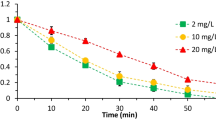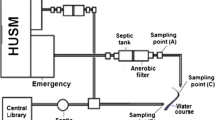Abstract
Carbamazepine (CBZ) is one of the most widely used antiepileptic drugs in Malaysia. It was detected frequently in wastewater. The electrochemical treatment process has been applied for the degradation of CBZ using graphite–PVC as an anode under these conditions: 0.5 g sodium chloride (NaCl)) as supporting electrolyte, 5 V and 0–60 min electrolysis time in 100 mL of solution. However, 10,11-dihydro10-hydroxy carbamazepine (HDX-CBZ) and 10,11-epoxycarbamazepine (EPX-CBZ) as the main by-product have been analysed and quantified using liquid chromatography–time of flight/mass spectrometry (LC-TOF/MS). Both by-products were analysed in positive ionization mode, and they were separated on a chromatographic C18 column (5 μm, 2 mm × 150 mm) at a flow rate of 0.3 mL/min. Solid-phase extraction (SPE) was applied as a pre-concentration step for the enhancement of the sensitivity and detectability for both HDX-CBZ and EPX-CBZ by-products. Methanol (MeOH) has been selected as the best elution solvent for both by-products compared to methyl tertiary butyl ether (MTBE) and acetone (AC). However, the recovery was 85% and 92% for HDX-CBZ and EPX-CBZ by-products, respectively. The limit of quantification (LOQ) was 0.588 and 0.109 µg/L for HDX-CBZ and EPX-CBZ by-products, respectively. After 20 min of electrolysis time, both by-products HDX-CBZ and EPX-CBZ appeared at maximum concentrations of 343 and 144 μg/L then they were decreased to 17.2 and 9.8 μg/L, respectively, after 40 min. At the end of electrochemical treatment, both by-products were completely eliminated after 60 min.






Similar content being viewed by others
Data availability
Not applicable.
References
Al-Odaini NA, Zakaria MP, Yaziz MI, Surif S (2010) Multi-residue analytical method for human pharmaceuticals and synthetic hormones in river water and sewage effluents by solid-phase extraction and liquid chromatography–tandem mass spectrometry. J Chromatogr A 1217(44):6791–6806
Al-Qaim FF, Abdullah MP, Othman MR, Latip J, Zakaria Z (2014) Multi-residue analytical methodology-based liquid chromatography-time-of-flight-mass spectrometry for the analysis of pharmaceutical residues in surface water and effluents from sewage treatment plants and hospitals. J Chromatogr A 1345:139–153
Al-Qaim FF, Abdullah MP, Othman MR, Mussa ZH, Zakaria Z, Latip J, Afiq WM (2015a) Investigation of the environmental transport of human pharmaceuticals to surface water: a case study of persistence of pharmaceuticals in effluent of sewage treatment plants and hospitals in Malaysia. J Brazil Chem Soc 26:1124–1135
Al-Qaim FF, Mussa ZH, Othman MR, Abdullah MP (2015b) Removal of caffeine from aqueous solution by indirect electrochemical oxidation using a graphite-PVC composite electrode: a role of hypochlorite ion as an oxidising agent. J Hazard Mater 300:387–397
Al-Qaim FF, Jusof SH, Abdullah MP, Mussa ZH, Tahrim NA, Khalik W, Othman MR (2017) Determination of caffeine in surface water using solid phase extraction and high performance liquid chromatography. Malay J Anal Sci 21(1):95–104
Al-Qaim FF, Mussa ZH, Yuzir A, Abdullah MP, Othman MR (2018a) Full factorial experimental design for carbamazepine removal using electrochemical process: a case study of scheming the pathway degradation. J Brazil Chem Soc 29:1721–1731
Al-Qaim FF, Mussa ZH, Yuzir A, Latip J, Othman MR (2018b) The fate of prazosin and levonorgestrel after electrochemical degradation process: monitoring by-products using LC-TOF/MS. J Environ Sci 74:134–146
Ding Y, Zhang W, Gu C, Xagoraraki I, Li H (2011) Determination of pharmaceuticals in biosolids using accelerated solvent extraction and liquid chromatography/tandem mass spectrometry. J Chromatogr A 1218(1):10–16
DrugBank (2020) https://www.drugbank.ca/drugs/DB00784. Accessed at 09 August 2020
Ekpeghere KI, Sim WJ, Lee HJ, Oh JE (2018) Occurrence and distribution of carbamazepine, nicotine, estrogenic compounds, and their transformation products in wastewater from various treatment plants and the aquatic environment. Sci Total Environ 640:1015–1023
Feng L, Van Hullebusch ED, Rodrigo MA, Esposito G, Oturan MA (2013) Removal of residual anti-inflammatory and analgesic pharmaceuticals from aqueous systems by electrochemical advanced oxidation processes.A review. Chem Eng J 228:944–964
García-Espinoza JD, Mijaylova-Nacheva P, Avilés-Flores M (2018) Electrochemical carbamazepine degradation: effect of the generated active chlorine, transformation pathways and toxicity. Chemosphere 192:142–151
Gros M, Petrović M, Barceló D (2006) Development of a multi-residue analytical methodology based on liquid chromatography–tandem mass spectrometry (LC–MS/MS) for screening and trace level determination of pharmaceuticals in surface and wastewaters. Talanta 70(4):678–690
Hai FI, Yang S, Asif MB, Sencadas V, Shawkat S, Sanderson-Smith M, Yamamoto K (2018) Carbamazepine as a possible anthropogenic marker in water: occurrences, toxicological effects, regulations and removal by wastewater treatment technologies. Water 10(2):107
Hernando MD, Petrovic M, Fernández-Alba AR, Barceló D (2004) Analysis by liquid chromatography–electrospray ionization tandem mass spectrometry and acute toxicity evaluation for β-blockers and lipid-regulating agents in wastewater samples. J Chromatogr A 1046(1–2):133–140
Kadhirvel P, Combès A, Bordron L, Pichon V (2019) Development and application of water-compatible molecularly imprinted polymers for the selective extraction of carbamazepine from environmental waters. Anal Bioanal Chem 411(8):1525–1536
Li Y, Yang Y, Lei J, Liu W, Tong M, Liang J (2021) The degradation pathways of carbamazepine in advanced oxidation process: a mini review coupled with DFT calculation. Sci Total Environ 779:146498
Malaysian Statistics on Medicine, Ministry of Health Malaysia, Kuala Lumpur, Malaysia. http://apps.who.int/medicinedocs/documents/s17580en/s17580en.pdf. Accessed 11 December 2020
Moreira FC, Boaventura RA, Brillas E, Vilar VJ (2017) Electrochemical advanced oxidation processes: a review on their application to synthetic and real wastewaters. Appl Catal B-Environ 202:217–261
Mussa ZH, Othman MR, Abdullah MP (2015) Electrochemical oxidation of landfill leachate: investigation of operational parameters and kinetics using graphite-PVC composite electrode as anode. J Brazil Chem Soc 26:939–948
Mussa ZH, Al-Qaim FF, Othman MR, Abdullah MP, Latip J, Zakaria Z (2017) Pseudo first order kinetics and proposed transformation products pathway for the degradation of diclofenac using graphite–PVC composite as anode. J Taiwan Inst Chem E 72:37–44
Na TW, Kang TW, Lee KH, Hwang SH, Jung HJ, Kim K (2019) Distribution and ecological risk of pharmaceuticals in surface water of the Yeongsan river, Republic of Korea. Ecotox Environ Safe 181:180–186
Nikolaou A, Meric S, Fatta D (2007) Occurrence patterns of pharmaceuticals in water and wastewater environments. Anal Bioanal Chem 387:1225–1234
Pereira D, Rocha LS, Gil MV, Otero M, Silva NJ, Esteves VI, Calisto V (2021) In situ functionalization of a cellulosic-based activated carbon with magnetic iron oxides for the removal of carbamazepine from wastewater. Environ Sci Poll Res 28:18314–18327
Perkons I, Rusko J, Zacs D, Bartkevics V (2021) Rapid determination of pharmaceuticals in wastewater by direct infusion HRMS using target and suspect screening analysis. Sci Total Environ 755:142688
Pierpaoli M, Dettlaff A, Szopińska M, Karpienko K, Wróbel M, Łuczkiewicz A, Bogdanowicz R (2021) Simultaneous opto-electrochemical monitoring of carbamazepine and its electro-oxidation by-products in wastewater. J Hazard Mater 419:126509
Quesada HB, Baptista ATA, Cusioli LF, Seibert D, de Oliveira BC, Bergamasco R (2019) Surface water pollution by pharmaceuticals and an alternative of removal by low-cost adsorbents: a review. Chemosphere 222:766–780
Sheng D, Zhu S, Zhang W, Bu L, Wu Y, Wang J, Zhou S (2021) Degradation of carbamazepine and disinfection byproducts formation in water distribution system in the presence of copper corrosion products. Chemosphere 282:131066
Sossalla NA, Nivala J, Reemtsma T, Schlichting R, König M, Forquet N, Escher BI (2021) Removal of micropollutants and biological effects by conventional and intensified constructed wetlands treating municipal wastewater. Water Res 201:117349
Teixeira JG, Veiga A, Carvalho AJP, Teixeira DM (2013) Electro-oxidation of carbamazepine metabolites: characterization and influence in the voltammetric determination of the parent drug. Electrochim Acta 108:51–65
Vieno NM, Tuhkanen T, Kronberg L (2006) Analysis of neutral and basic pharmaceuticals in sewage treatment plants and in recipient rivers using solid phase extraction and liquid chromatography–tandem mass spectrometry detection. J Chromatogr A 1134(1–2):101–111
Xu L, Niu J, Xie H, Ma X, Zhu Y, Crittenden J (2021) Effective degradation of aqueous carbamazepine on a novel blue-colored TiO2 nanotube arrays membrane filter anode. J Hazard Mater 402:123530
Zhang ZL, Zhou JL (2007) Simultaneous determination of various pharmaceutical compounds in water by solid-phase extraction–liquid chromatography–tandem mass spectrometry. J Chromatogr A 1154(1–2):205–213
Zhang Y, Geißen S-U, Gal C (2008) Carbamazepine and diclofenac: removal in wastewater treatment plants and occurrence in water bodies. Chemosphere 73(8):1151–1161
Zhang Y, Duan L, Wang B, Liu CS, Jia Y, Zhai N, Yu G (2020) Efficient multiresidue determination method for 168 pharmaceuticals and metabolites: optimization and application to raw wastewater, wastewater effluent, and surface water in Beijing, China. Environ Poll 261:114113
Zhang Z, Chen H, Wang J, Zhang Y (2020) Degradation of carbamazepine by combined radiation and persulfate oxidation process. Radiat Phys Chem 170:108639
Zhu L, Santiago-Schübel B, Xiao H, Thiele B, Zhu Z, Qiu Y, Küppers S (2015) An efficient laboratory workflow for environmental risk assessment of organic chemicals. Chemosphere 131:34–40
Zou R, Tang K, Angelidaki I, Andersen HR, Zhang Y (2020) An innovative microbial electrochemical ultraviolet photolysis cell (MEUC) for efficient degradation of carbamazepine. Water Res 187:116451
Acknowledgements
Support for this study was provided by the Central Research Instrumentation of Management, Universiti Kebangsaan Malaysia. The authors would like to thank all staff in the centre.
Author information
Authors and Affiliations
Contributions
Zainab Haider Mussa: lab work, methodology, data collection, electrochemical cell construction.
Fouad Fadhil Al-Qaim: methodology, validation, writing (original draft), writing (editing), elucidation the by-products.
Corresponding author
Ethics declarations
Ethics approval and consent to participate
Not applicable.
Consent for publication
Not applicable.
Competing interests
The authors declare no competing interests.
Additional information
Responsible Editor: Ester Heath
Publisher's note
Springer Nature remains neutral with regard to jurisdictional claims in published maps and institutional affiliations.
Supplementary Information
Below is the link to the electronic supplementary material.
Rights and permissions
About this article
Cite this article
Mussa, Z.H., Al-Qaim, F.F. Quantification of 10,11-dihydro-10-hydroxy carbamazepine and 10,11-epoxycarbamazepine as the main by-products in the electrochemical degradation of carbamazepine. Environ Sci Pollut Res 29, 62447–62457 (2022). https://doi.org/10.1007/s11356-022-20091-7
Received:
Accepted:
Published:
Issue Date:
DOI: https://doi.org/10.1007/s11356-022-20091-7




